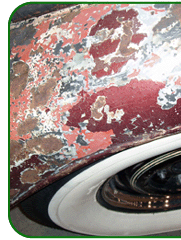What Will It Be ...
...Patina or Paint Job For Your Hot Rod?
Appreciating Hot Rod Patina
Lately you may have been hearing a lot about patina and old cars. Not just rat rod patina anymore, patina is gaining stature as a rich
and varied art form.
Even if a glossy paint job suits your fancy, most likely you appreciate the many beautiful patina-coated vehicles encountered at the hot
rod shows, where more and more vintage car owners are displaying nature at its finest.
What Is Patina?
On antique cars, patina evolves from a chemical coating of various compounds, such as
oxides or carbonates, that rises to the surface of metal during weathering from exposure to natural elements.
We’ve all observed old copper that has turned green. The green patina that forms naturally on copper and bronze is known as verdigris and
consists of copper carbonate.

Patinas are restricted to exposed surfaces and can flake off. Observe the weathered layers of patina on this image of a deeply patinated
hot rod fender.
In works of art, a variety of patinas can be obtained from a wide range of household and
commercial chemicals. They are often used by artists as surface embellishments, for color and/or texture.
One reason bronze is so highly valued in statuary is that its patina protects or passivates it against further corrosion. This natural patina
seldom shows a tendency to flake.
The chemical process by which a patina forms is called patination, and a work of art coated by a patina is said to be patinated.
The composition of patination varies with the elements that react to create it. These reactive elements determine the color of the patina. For
example, exposure to chlorides leads to green. Sulfur compounds (such as “liver of sulfur”) tend to brown.
Artists often deliberately accelerate patination by using heat. Colors range from matte sandstone yellow to deep blues, reds and various
blacks, sometimes with the surface sheen enhanced by waxing for artwork displayed indoors.
In the world, patina is not just for metal surfaces. Patina is everything that happens to an
object over the course of time.
 |
The nick in the leg of a wooden table |
 |
A scratch on a table top |
 |
Loss of moisture in the paint |
 |
Crackling of a finish or a glaze in ceramics |
 |
Gentle wear patterns on the edge of a
plate. |
All these things add up to create a softer look, subtle color changes, character. As proof of life, patina is built from all the effects,
natural and man-made, that create a true antique.
Why Might You Allow Your Vintage Car's Surface To Patina?
Patina’s unique character cannot be purchased for any price, or duplicated with any pretense of dignity. There are those who attempt to
artificially replicate nature’s patina, but such attempts lack patina's grace.
For years the hot rod industry has focused on its elimination, destroying it and chroming away all of its character and remembrance.
Today, patina fans are growing, not only from the
culture of rat rodders, but from converts of billet and chrome.
| 













